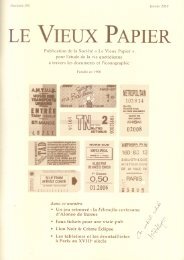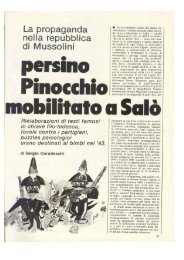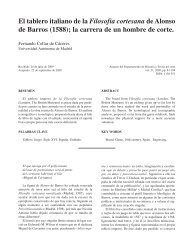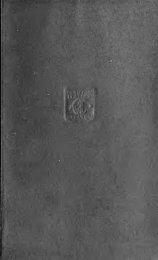Board games from the city of Vijayanagara (Hampi ... - Gioco dell'Oca.
Board games from the city of Vijayanagara (Hampi ... - Gioco dell'Oca.
Board games from the city of Vijayanagara (Hampi ... - Gioco dell'Oca.
You also want an ePaper? Increase the reach of your titles
YUMPU automatically turns print PDFs into web optimized ePapers that Google loves.
50<br />
B OARD G AME S TUDIES 6, 2003<br />
“carnival’s procession” was typical Nazi cynicism making a joke out <strong>of</strong> <strong>the</strong> Exodus story<br />
<strong>from</strong> <strong>the</strong> Bible. (2) The fact that <strong>the</strong> expulsion <strong>of</strong> <strong>the</strong> Jews has been made a subject <strong>of</strong> <strong>the</strong><br />
procession seems to fit very well into <strong>the</strong> general <strong>the</strong>me and graphic imagery <strong>of</strong> <strong>the</strong> game<br />
and may have inspired <strong>the</strong> <strong>games</strong> anonymous author.<br />
There are two types <strong>of</strong> game pieces. The “men” clearly represent <strong>the</strong> German Police<br />
and can be identified by <strong>the</strong> coat and belt drawn on <strong>the</strong> pieces, as well as <strong>the</strong> cone like<br />
hat, buttons and boots which appear very similar to <strong>the</strong> uniforms worn by <strong>the</strong> German<br />
police at <strong>the</strong> time (Berenbaum 1993). The pieces are made <strong>of</strong> painted wood, and measure<br />
5.8 cm x 1.8 cm. (figure 2). The “hats” are 3.5 cm in height, 1 cm in diameter and<br />
are made <strong>of</strong> paper and may have yellowed with age. The faces on <strong>the</strong> hats are drawings<br />
<strong>of</strong> grotesque stereotypes <strong>of</strong> Jewish facial features similar to those drawn on <strong>the</strong> game<br />
board. One copy <strong>of</strong> <strong>the</strong> game has a lea<strong>the</strong>r beaker for throwing dice but Mr. Barkow<br />
was uncertain whe<strong>the</strong>r this came with <strong>the</strong> game or was added by <strong>the</strong> anonymous donor.<br />
Game Rules [as translated <strong>from</strong> <strong>the</strong> German] (figs. 3 & 4) (3)<br />
“JEWS OUT!<br />
The up-to-date and outstandingly jolly party game for grown-ups and children.<br />
From 2 to 6 players can take part in this extraordinarily amusing and up-to-date<br />
family game.<br />
Equipment: 1 die, 6 figures and 36 little hats. Each player takes one <strong>of</strong> <strong>the</strong> figures<br />
numbered 1 to 6.<br />
The method <strong>of</strong> play is as follows:<br />
Each player rolls <strong>the</strong> die and places his figure on <strong>the</strong> start-square <strong>of</strong> <strong>the</strong> street whose<br />
number is equivalent to that <strong>of</strong> <strong>the</strong> number thrown. Whoever occupies Street One is<br />
<strong>the</strong> leader and plays first. Each in turn <strong>the</strong>n rolls <strong>the</strong> die and moves his figure <strong>the</strong> appropriate<br />
number <strong>of</strong> spaces towards <strong>the</strong> central square. If, having crossed <strong>the</strong> town wall, he<br />
lands on a square marked with a Jewish house, he gets a hat <strong>from</strong> <strong>the</strong> game leader and<br />
caps his figure with it. On his next throw he starts moving his figure back towards <strong>the</strong><br />
collection-point and hands <strong>the</strong> hat back in. If a player has thrown a six (for example) and<br />
is now three spaces away <strong>from</strong> <strong>the</strong> collection point, he can hand <strong>the</strong> hat in and <strong>the</strong>n go<br />
forwards three spaces. This coming and going between <strong>the</strong> town wall and <strong>the</strong> central<br />
square continues until one player has got six hats over to <strong>the</strong> collection point. Having<br />
handed in his sixth hat, he <strong>the</strong>n goes back over <strong>the</strong> numbered squares to <strong>the</strong> central<br />
square. The first to do this wins First Prize. The o<strong>the</strong>r players can ei<strong>the</strong>r carry on playing<br />
for position, or divide <strong>the</strong> remaining prizes among <strong>the</strong>mselves according to how<br />
many hats <strong>the</strong>y managed to collect.<br />
Ano<strong>the</strong>r method <strong>of</strong> play:<br />
When a figure has been capped, <strong>the</strong> person playing it continues moving forwards,<br />
according to <strong>the</strong> number thrown, towards <strong>the</strong> central square. If he <strong>the</strong>re encounters<br />
ano<strong>the</strong>r figure with a hat or hats, he can capture its hat or hats and bring <strong>the</strong>m back to<br />
his own collection point. In following this method <strong>of</strong> play, it is possible for a player who







